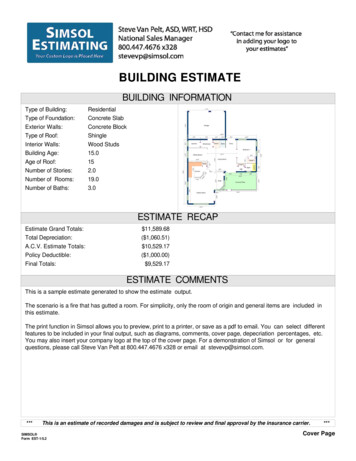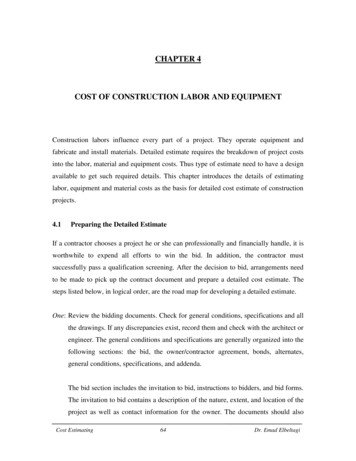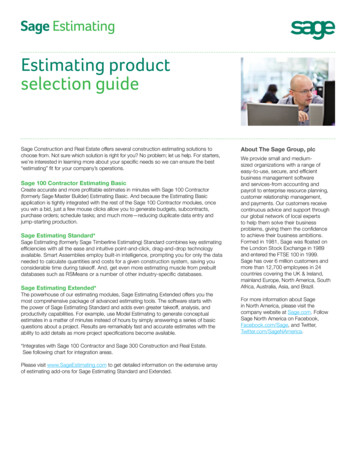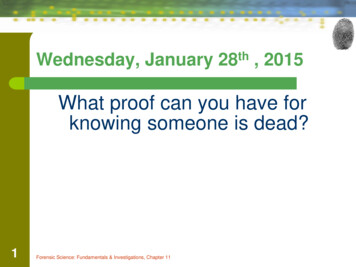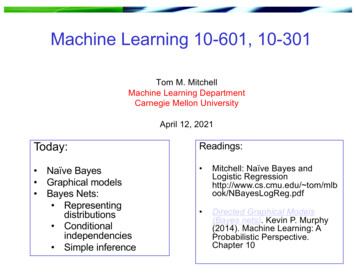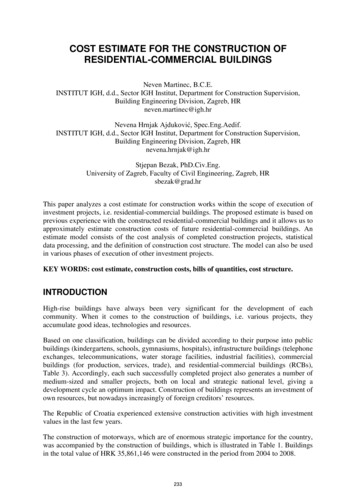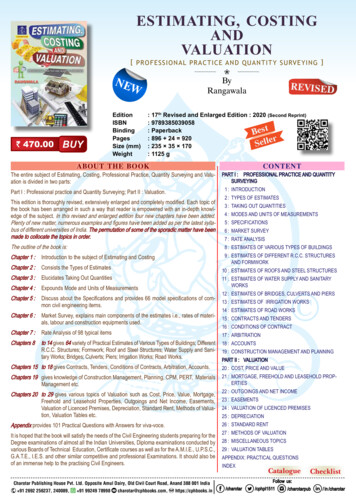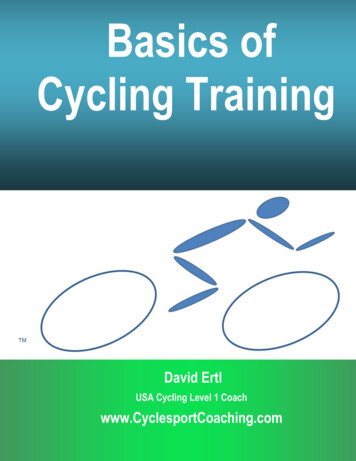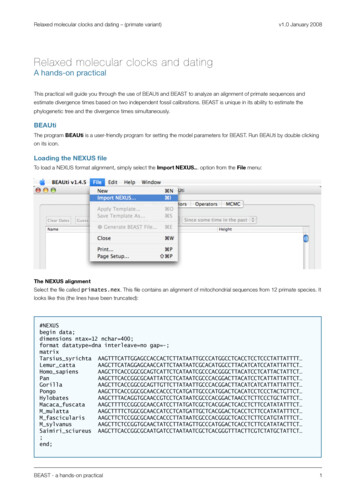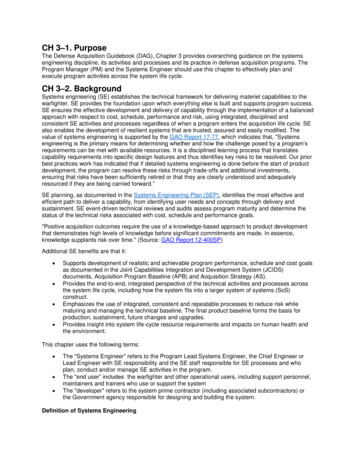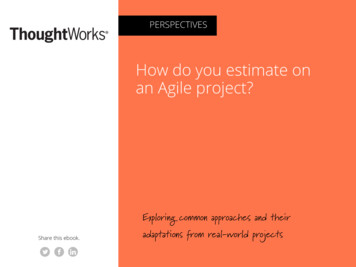
Transcription
PERSPECTIVESHow do you estimate onan Agile project?Exploring common approaches and theirShare this ebook.adaptations from real-‐world projects
ContentsIntroduction3Why do we estimate?4Purpose of Estimation -- Martin FowlerHow do we estimate?58All about Points -- Anand Vishwanath9Stop saying “estimate” -- JK Werner12The Bucket Theory -- Malcolm Beaton13Using points is not the point -- Juliano Bersano16Estimating without points -- Ian Carroll19In Practice21Estimating on a distributed team -- Jiangmei Kang22How story counts worked for us -- Huimin Li24In Summary29About the authors30Be in this ebook32 2013Share this ebook:2
Estimation can be a difficult beast to deal with; more so on anAgile project. How do you estimate when you don’t have a list ofrequirements that is complete or signed-off by the customer? Ora nailed-down schedule? What should your currency ofestimation be? How do you estimate on a distributed team? Is itworth estimating at all?Let’s analyze these questions,starting with the basics 2013Share this ebook:3
Why do weestimate? 2013Share this ebook:4
“Purpose ofEstimation”An analysis of the reasons why weestimate to improve our estimationeffortsMy first encounter with agile software developmentIn this narrative, effort put into estimates is, at best,was working with Kent Beck at the dawn of Extremewaste - since "an estimate is a guess in a cleanProgramming. One of the things that impressed meshirt". Usually estimates end up being activelyabout that project was the way we went aboutharmful as they encourage FeatureDevotion, aplanning. This included an approach to estimatingnasty condition where people start valuing tickingwhich was both lightweight yet more effective thanoff features more than tracking the real outcome ofwhat I'd seen before. Over a decade has nowthe project.passed, and now there is an argument amongstexperienced agilsts about whether estimation isworth doing at all, or indeed is actively harmful. Iestimates are usually too low, they set unrealisticthink that to answer this question we have to lookexpectations. Any increase in time or reduction into what purpose the estimates will be used for.features is then seen as a loss. Due to loss-A common scenario runs like this: Martin, Chief ScientistEstimates also set expectations, and since Developers are asked for (or given) estimatesFaced with situations like this, it's easy to see howfor upcoming work. People are optimists, sopeople turn their angry glares towards estimation.these estimates tend to be too low, evenThis leads to an increasing notion that anyonewithout pressure to make them low (andindulging in estimating is Not a True Agilist. Criticsthere's usually at least some implicit pressure)of agile say this means that agile development isThese tasks and estimates are turned intorelease plans tracked with burn-down charts. aversion, these losses have a magnified effect.Time and effort goes into monitoring progressagainst these plans. Everyone is upset whenactuals end up being more than estimates. Ineffort to increase pace with the estimates,developers are told to sacrifice quality, whichonly makes things worse.about developers going off and doing vague stuffwith promises that it'll be done when its done andyou'll like it.I don't share this view of estimation as aninherently evil activity. If I'm asked if estimation is aBad Thing my answer is the standard consultants'answer of "it depends". Whenever someoneanswers "it depends" the follow-up question is"upon what".(continued.) 2013Share this ebook:5
(.continued)“Purpose ofEstimation”An analysis of the reasons why weestimate to improve our estimationeffortsSo whenever you're thinking of asking for anTo answer that we have to ask why we are doingestimation - as I like to say "if it's worth doing well,it's worth asking why on earth you're doing it at all".For me, estimation is valuable when it helps youmake a significant decision.My first example of an estimation-informedestimate, you should always clarify what decisionthat estimate is informing. If you can't find one, orthe decision isn't very significant, then that's asignal that an estimate is wasteful. When you dofind a decision then knowing it focuses theestimate because the decision provides context. Itshould also clarify the desired precision andaccuracy.decision is allocation of resources. Organizationshave a mostly fixed amount of money and people,Understanding the decision may also lead you toand usually there are too many worthwhile thingsalternative actions that may not involve anto do. So people are faced with decisions: do we doestimate. Maybe task A is so much more importantA or B? Faced with such a decision it's useful tothan B that you don't need an estimate to put allknow how much effort (and cost) each will involve.your available energies into doing it first. PerhapsTo make sensible decisions about what to do, youthere is a way for blue team members to work withneed to have a feel for both the cost and thethe green team to get the service built morebenefits.quickly.Another example is to help with coordination. TheSimilarly, tracking against a plan should also beblue team wants to release a new feature to theirdriven by how it informs decision making. My usualweb site, but cannot do so until the green teamcomment here is that a plan acts as a baseline tobuilds a new service to give them crucial data. If thehelp assess changes - if we want to add a newgreen team estimates they will be done in twofeature, how do we fit it into the FivePoundBag?months and the blue team estimates that it willEstimates can help us understand these trade-offstake them a month to build the feature, then theand thus decide how to respond to change. On ablue team knows it's not worthwhile to start today.larger scale re-estimating a whole release can helpThey can spend at least a month working on someus understand if the project as a whole is still theother feature that can be released earlier.best use of our energy.(continued.) 2013Share this ebook:6
(.continued)“Purpose ofEstimation”An analysis of the reasons why weestimate to improve our estimationeffortsGo to any conference with agile leanings and you'llA few years ago we had a year-long project thatwas cancelled after a re-estimate a couple ofmonths in. We saw that as a success because there-estimate suggested the project would take muchlonger than we had initially expected - earlycancellation allowed the client to move resourcesto a better target.hear talks of teams that work effectively withoutestimation. Often this works because they, andtheir customers, understand that making estimatesisn't going to affect significant decisions. Anexample is a small team working closely withbusiness. If the broader business is happy withallocating some people to that business unit, thenwork can be carried out in priority order; often thisBut remember with tracking against plans thatestimates have a limited shelf life. I once remembera gnarly project manager say that plans andestimates were like a lettuce, good for a couple ofdays, rather wilty after a week, and unrecognizableafter a couple of months.Many teams find that estimation provides a usefulforcing function to get team members to talk toeach other. Estimation meetings can help get betterunderstanding of various ways to implementupcoming stories, future architectural directions,and design problems in the code base. In this caseany output estimation numbers may beunimportant. There are many ways suchconversations can happen, but estimationdiscussions can be introduced if these kinds ofconversations aren't happening. Conversely ifyou're thinking of stopping estimation, you need toensure that any useful conversation duringestimation still continues elsewhere. 2013is helped by the team breaking down work intosmall enough units. A team's level in the agilefluency model plays a big role here. As teamsprogress they first struggle with estimation, thencan get quite good at it, and then reach a pointwhere they often don't need it.Estimation is neither good or bad. If you can workeffectively without estimation, then go ahead anddo without it. If you think you need someestimates, then make sure you understand theirrole in decision making. If they are going to affectsignificant decisions then go ahead and make thebest estimates you can. Above all be wary ofanyone who tells you they are always needed, ornever needed. Any arguments about use ofestimation always defer to the agile principle thatyou should decide what are the right techniques foryour particular context.(Originally published at html)Share this ebook:7
How do weestimate?There are amyriad ways!Let’s see a fewPOVs. 2013Share this ebook:8
“All about points”101 on Story PointsWhat is a Story Point ?Teams are able to estimate much more quicklyIt is a subjective unit of estimation used by Agilewithout spending too much time in nailing downteams to estimate User Stories.the exact number of hours or days required toWhat does a Story Point represent ?They represent the amount of effort required toimplement a user story. Some agilists argue that itis a measure of complexity, but that is only true ifthe complexity or risk involved in implementing auser story translates into the effort involved inimplementing it.What is included within a Story Point estimate ?It includes the amount of effort required to get thestory done. This should ideally include both thedevelopment and testing effort to implement astory in a production-like environment.Why are Story Points better than estimating inAnand, PM, BA, Agile coachhours or days ?finish a user story.How do we estimate in points ?The most common way is to categorize them into 1,2, 4, 8, 16 points and so on. Some teams prefer touse the Fibonacci series (1, 2, 3, 5, 8). Once thestories are ready, the team can start sizing the firstcard it considers to be of a “smaller” complexity.For example, a team might assign the “Login user”story 2 points and then put 4 points for a “customersearch” story, as it probably involves double theeffort to implement than the “Login user” story.This exercise is continued till all stories have a storypoint attached to them.Who should be involved in Story Pointestimation ?Story point estimation is done using relative sizingThe team who is responsible for getting a storyby comparing one story with a sample set ofdone should ideally be part of the estimation. Theperviously sized stories. Relative sizing acrossteam’s QAs should be part of the estimationstories tends to be much more accurate over aexercise, and should call out if the story haslarger sample, than trying to estimate eachadditional testing effort involved.individual story for the effort involved.For example supporting a customer search screenAs an analogy, it is much easier to say that Delhi toon 2 new browsers might be a 1 point developmentBangalore is twice the distance of Mumbai toBangalore than saying that the distance from Delhito Bangalore is 2061 kms.effort but a lot more from a testing perspective.QAs should call this out and size the story to reflectthe adequate testing effort.(continued.) 2013Share this ebook:9
(.continued)“All about points”101 on Story PointsShould we do a best, likely, worst case estimateFor example, if the result of 3 picks was 6, 8 and 10even when we are estimating in points ?points for a 2 week iteration then (10 8 6)/3 8This can be done by providing 3 different pointpoints is the raw velocity for the team for 2 weeks.values for the best, likely and worst case scenarios.A schedule can then be laid out assuming the teamIt is quite effective when estimating a large samplefinishes 8 points in a 2 week iteration.set of stories especially during the first release ofthe project where little code has been written.Doing this provides a range across which estimatesmay vary depending on outcomes of certainassumptions made. For example a best caseestimate for the Login story could be 2 pointsassuming integration with a local LDAP server, butif that assumption changes to a 3rd party providerintegration, the worst case could be 8 points.Can Story Points be standardized across variousteams ?Different teams will have different measures ofstory points based on the set of stories they aresizing. Unless they are building the same system,the effort required to finish a 1-point story by teamA will differ from that required by team B in theirsystem. This difference will reflect in the velocitiesof teams A and B.How do we plan/schedule a project using StoryIf there is a large program of work split amongstPoints ?multiple teams, it is tempting to attempt toTo do that, the team needs to calculate theirstandardize the point scale across these teams.velocity in terms of number of points the team canThis defeats the purpose of estimating using storydeliver in an iteration. This is typically done usingyesterday’s weather by averaging the velocityachieved by the team in the last 3 iterations.points and it being a unit of measure subjective toa team.How do we estimate spike stories in points ?If the team is starting afresh, then a raw velocitySpike stories are played to better understand howexercise is done, where the team decides howto implement a particular feature, or as a proof ofmany stories it can finish in an iteration. This isconcept. Since in a spike very little is known aboutdone by repeatedly picking different sample sets ofthe amount of effort involved, it is typically time(previously-sized) stories which can be done withinboxed with an outcome that the team can agreean iteration. Average the total points acrossupon. This can be approximately converted intodifferent picks to get the team’s iteration velocity.points by looking at the velocity trend.(continued.) 2013Share this ebook:10
(.continued)“All about points”101 on Story PointsFor example, if it is required to plan a week-longHow do we know if the team is getting better atspike, and the team velocity is 16 points, then weestimation when it is estimating in points ?can assign 8 points to the spike story.It is a popular belief that if the team were toIs there a way we can calculate cost per point ?Cost per point will typically be (Cost of aniteration) / (Velocity per iteration (in points)). Incases where there is an additional stabilizationsprint or regression iteration, the cost of thatiteration should also be included.estimate in ideal days, then it would be mucheasier to track if the estimation is accurate, bychecking the actual days elapsed on a story and theprogress against it. This is however counterproductive as the team spends hours to estimatefew stories to arrive at the magic number of daysbefore being pressurized to deliver on that magicAre story points an excuse for teams not beingnumber.able to estimate correctly in days/hours?When a team is relatively sizing stories in points, aThe effort and time required to arrive at antrend slowly starts emerging where similarly sizedaccurate number in days/hours for a story weighsstories start showing similar time to implementagainst the benefits of estimating as such.them. If there is a bad estimate, then that bubblesMoreover estimating in days/hours puts undueup automatically as an exceptionpressure on the team to deliver within thoseShould developers change their story pointnumber of days, leading to the team unable toreach a sustainable pace, and possibly burningout .estimation as they learn more about the systemthey are building ?If a story A was classified in the 2 points bucket, aDo Story Points relate to Business Value ?similar story B coming in months later should beStory points are an internal measure of effortclassified in the same bucket. If the team has learntinvolved in implementing a user story. It does not,more about implementing them between whenin any way, reflect the amount of business value astory A and story B were played, this will show upuser story provides. There might be cases where aas an increase in velocity of the team.1-point story might provide a lot of business valueIt is good to setup a “relative sizing triangulationversus a 4-point story in the same system. Businessvalue is best left for the product owner andbusiness stakeholders to be able to determine. 2013board” for the team with placeholder stories fromthe initial estimation session, for the team to relateto while sizing a new story.Share this ebook:11
“Stop sayingestimate”The subtle but important distinctionbetween estimating & sizingThere is a certain connotation with the wordAs soon as we talk about estimating stories theestimate. People think of cost and time. Thinkclient (and team) naturally start to think about theabout the last time a mechanic fixed your car ortime it will take to complete a story and how muchyou hired a painter to put a fresh coat of paint onthat story costs. This leads to people wanting tothe third floor windows. You are thinking aboutchange the number of points associated to a storytime and cost aren't you? When we start thinkingbecause "it is taking longer than the estimate". Justabout a software project we are still estimating thebecause a story has taken longer than anticipated,cost and time, but of the project not the stories.does that mean its relative size is different to all theWe are doing ourselves a disservice when we sayother stories? Maybe. but most often it is that ourwe estimate our stories.velocity is not what we initially thought it would be.We have been relatively sizing stories on projectsfor years. We are not estimating our stories. Whenwe look at a group of stories it is pretty easy tocompare them relatively to each other and have aJK, PM, BA, Agile coachTalking about the size of the story helps to focus onthe velocity being the value that is different fromexpectations rather than the number of points onthe story.good understanding of which ones are similar. TheWith this mind set, we can move away fromhard part is to predict how fast we will finish eachconstantly updating the the number of points onstory. It is the velocity at which we completeevery story and instead focus on improving ourstories, combined with the total number of points,velocity by finding ways to be more effective andwhich allows us to estimate the project's cost andreducing waste.length.So why does it matter if we size our stories orestimate them? 2013Share this ebook:12
“The Bucket Theory”A fruity analogy to relative sizingOver a year of presenting agile fundamentals toFocus on people? On your team, pick who youteams has taught me that the topic of estimationthink is the best developer (A) and the worst (B).seems to strike fear and horror into people. TheNow pick a story. How many hours would it take Aprocess of estimating seems to go something liketo deliver it and how many hours would it take B?this:Do we put two estimates on it? If yes, how do weforecast work? If no, how do we deal with the1.Pick a story2.See the code base3.Talk about how you would implement the story4.Get the BA and beat them for exact details ofdisparity between who is doing it? This often leadshow the solution should lookbased on who is going to actually implement thestories – which short changes the business.Get the QA and beat them for exact details ofhow they are going to test itOr on time? Story 125 might be interesting to do if6.Wring hands for a bit. Panic a littlewe have a problem with estimating in time. Though7.Assume because it’s in component A and Jeff is5.the component A guy, and he is pretty quick maybe a few days?Malcolm, Principal Consultantto last-minute estimation during iteration planning8.Stick a finger in the air and say “Well 3 days X 8hrs. is 24 so 24 hrs.!it takes 3 days, but not if it takes 6. So immediatelyit is seductive and all teams try it for a bit.Or a better way? Let’s say I am a voracious eaterof fruit and let’s say my mate is slower than me. If ittakes me 2 minutes to eat an apple, it takes him 4.Let’s suppose delivering your project is similar to usAlright, maybe its not quite as painful as that for alltrying to eat all the fruit in a bowl. The pieces ofteams but what if I told you that on at least onefruit represent stories and I have some plums,project I worked on we estimated a years worth ofapples, bananas, mangos and some melons.stories in a few days without actually knowing toomuch about them? In itself not that remarkable,After all we could have just randomly assignednumbers to them, but the really remarkable bit iswe delivered almost exactly to schedule!I know a plum is about half the size of an apple anda banana takes about as long to eat as a plum. Amango will take me about twice as long as theapple and the melons about 4 times.So I can allocate them into buckets that representSo, how should true agile estimation be done?the relative size and complexity of the fruit:(continued.) 2013Share this ebook:13
(.continued)“The Bucket Theory”A fruity analogy to relative sizingPlum/Banana 1, Apple 2, Mango 4, Cantaloupe 8But I hear you say – “Surely this is just working outrelative size using time so why not just use time?”Because relative size remains the same no matterwho eats the fruit. My mate who takes 4 minutes toeat the apple will take 2 minutes to eat a banana and32 minutes to eat the cantaloupe but the relative sizestays the same.This approach is often easier, as teams can look attwo stories and very quickly see one is half ascomplex or twice as complex as another. Without allthe painful processing at the beginning! I have seenteams do this with hundreds of stories in a matter ofhours. So, we now have a unit of size we can agreeSo let’s now take a look at the fruit bowl:12 plums x 1 12 points6 bananas x 1 6 points6 apples x 2 12 points3 mangos x 4 12 points2 cantaloupes x 8 16 Pointson, we’ll call them Story Points.The scope of our fruit bowl is 58, which isn’t divisible“But that doesn’t change the speed you and yourmovie tickets (i.e. it doesn’t make sense to buymate eat fruit, right?” Well, this is the best bit, it0.866666 movie tickets) we round it to 4. We shoulddoesn’t matter what speed the members of the teamthus have eaten all the fruit in the bowl in 40work at. If I break our fruit-eating task into iterationsminutes - our estimated release date.of 10 minutes, my mate and I can eat 15 pointsworth of fruit per iteration (I eat 1 point/minute andhe eats 1 point/2 minutes) We’ll call this 15 our “teamvelocity”. As this looks at the team as a whole, it thusabsorbs differences in speed between developers. Inagile as always it’s all about the team! (If you aretrying to work out individual velocities, stopimmediately – it is the path to madness and createsunderperforming teams.)by 15 (our team velocity). As iterations are a bit likeThis now empowers our product owner to work withthe scope to adjust the release date. Add 6 applesand the delivery gets pushed by an iteration orremove both cantaloupes and deliver an iterationearlier, or take out all the bananas and 10 plums andadd two more cantaloupes and we should deliver atthe same time (though probably with an abidinghatred of cantaloupes).(continued.) 2013Share this ebook:14
“The Bucket Theory”A fruity analogy to relative sizing(.continued)FAQs:Enough with the fruit!Why these buckets? What if we have a 100 point story?How do we apply these techniques to our projects? To start with, always estimate stories againsteach other, not individually. We thus need tohave a frame of reference, to relatively “size”the stories. Pick a story that feels smallish (butnot the smallest) and call it a 2. Use this as areference. Relatively size each story against the benchmark story by discussing only theimplementation details that affect its size. Fore.g., if the decision to use SQL Server vs. Oracledoesn’t alter the story’s relative size, don’tIt goes into the 16 Bucket. The 16 bucket is also acatch-all bucket for stories too big or too poorlyunderstood to estimate.Why do we have such strict limits on the sizes ofstories?Primarily for the sake of accuracy. I can bereasonably accurate relatively sizing the fruit in thefruit bowl but once you start asking me “How manyapples in the empire states building” I pretty muchhave no idea. So having stories that don’t size isn’tuseful. They can’t be delivered in an iteration andinevitably turn into mini waterfall projects.discuss it. Capture all assumptions.But, surely some of the estimates will be wrong? Put each story into a bucket 1, 2, 4, 8 or 16.That’s true, but once you have your estimates don’t Try to keep your story size small. Ideally an 8should be able to be delivered in one iteration.Anything bigger, and it’s best to use an “epic” toindicate that it needs to be broken down. For each story bucket, do a quick review of thestories in them and their estimates. Are they allreasonably close in “size” to each other? Shiftbuckets if required. re-estimate the stories. There is a simple reason forthis. On most projects you’ll have a couple of 2pointers that turn out to be 8’s and a couple of 8’sthat turn out to be 2‘s.What happens when we permit re-estimation isprobably pretty obvious – The 2 pointers become8’s and the 8’s . stay 8’s. So by not allowing reestimation we pay back the debt of the bigger thanexpected 2 with the smaller than expected 8 andThen work out your current understood scopeeverything just kind of works.just by adding up the numbers. 2013Share this ebook:15
I have done 3 projects in a row where we did notPM: Yes, but 100 points from then turned into 130,use story points and simply counted stories. I’m abecause we now know more about the complexity.“Using points is notthe point”big advocate of that approach. Let me explain why.Sponsor: But it is the same scope and businessAn analytical argument on whyestimation shouldn’t be focused on pointspoints, COCOMO, and story points for over 10I'm an estimation geek who loves the nuances ofestimation, and have used function points, use caseyears. Over time, I’ve become convinced that themore we estimate past the very initial point, the lessaccurate we get. Additionally, long-drawn,“scientific” estimation exercises generate wrongexpectations of certainty. Does this sound familiar?objective. We haven't changed it! Hmm.I can't seehow that story is a 5-pointer, it looks like a 3. Let’sreview all the estimates.We all know how this story plays. Business feelstricked by our "bloating" of points (and in theirperspective, not of the scope.)On the last 3 projects, I measured average days/point and the standard deviation of same-sizedPM: Your original scope was 100 points, but now itstories. I found the spread to be very similar towent up to 130 points, so you have to cut 30 tocalculating average days/story and its standarddeliver the release in the original timeline.Sponsor: But the scope is the same. We havedeviation. Using points did not give us morepredictability.exactly the same 30 stories from when we started!Juliano, Agile coach, Delivery LeadBurnup over 1 year (6 releases)Green Sum of PointsBlue Story CountOn comparing burnup charts of the sum ofpoints and story count, I get exactly thesame insights in terms of progress.I would also draw exactly thesame kind of conversations, whichis the real "point" here.(continued.) 2013Share this ebook:16
In Summary:(.continued)“Using points is notthe point”I now prefer to have a different conversation withclients using these two ways:1.An analytical argument on whyestimation shouldn’t be focused on pointsI do think that there is an evolving progression in ateam’s approach to estimation:Define release scope not in terms of stories1.Estimate in effort (days, weeks etc.).but in terms of features we're delivering2.Estimate in points (use case / story points etc.).and their business objectives.3.Estimate by counting stories/cards. To ease thetransition, I generally say, "Let's assume allstories are 3 points and split those that aren't",and multiply every story by 3. This helps todrive right behavior towards smaller, similarsized work packages that give you more flow.4.Forget estimates and simply work oncontinuous flow, focusing on cycle time.Points represent 3 types of scope:(1) Feature/function(2) Richness/usability/depth(3) Technical complexityHowever clients generally only consider thefirst one and get confused when we say “scopeincreased” due to the other two types, as theirbusiness objective has not changed.2.Now, to get to each stage there must be somestakeholder buy-in. I have had honestDiscuss scope in terms of projected numberconversations to the tone of "We can game theof stories we think we can do (forget points)points all day long, but that won't get your businessand put rules around the maximumduration of a story.outcomes delivered, so what would you rather do?”Sometimes the answer has been that they can'tFor example, the team should not pick anyhelp it and still want to fight points, so fight pointsstory that they think will take more than max we do until we can change it.days to complete. So if the “scope” (any of the 3types) increases , the story can be split and theFAQs:last one in the queue might fall out.I like cycle time and features as metrics. But how doNot only are these conversations easier, but theyyou handle that (often long) period before the formeralso get people focused on simplifying the last twostabilizes?aspects of scope that don't “directly” contribute toThere is no magic bullet. (Projected) velocity orthe business objective, so they can actually get(projected) cycle time can help you take a call as tomore of "their scope" (features/functions) in. Andhow much you can deliver in a certain time.we don't get into (endless) discussions about points(continued.)and sizing stories. 2013Share this ebook:17
(continued.)“Using points is notthe point”An analytical argument on whyestimation shouldn’t be focused on points1.Thus story culling happens more
of agile say this means that agile development is about developers going off and doing vague stuff with promises that it'll be done when its done and you'll like it. I don't share this view of estimation as an inherently evil activity. If I'm asked if estimation is a Bad Thing my an
